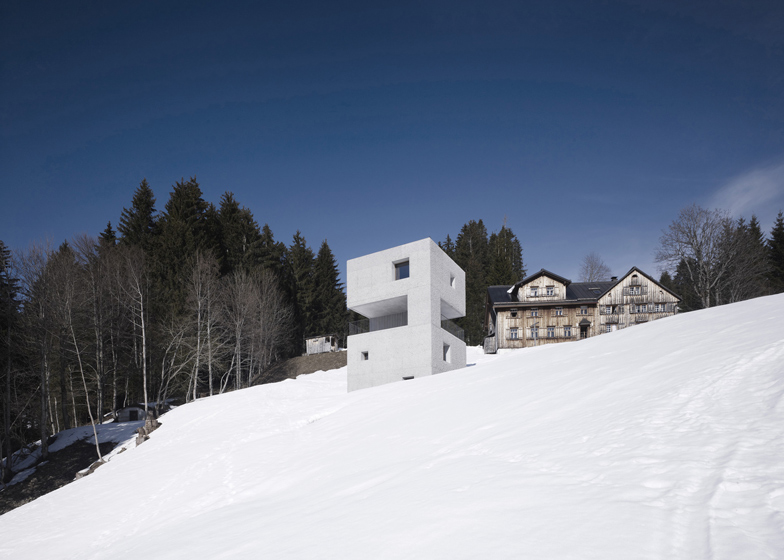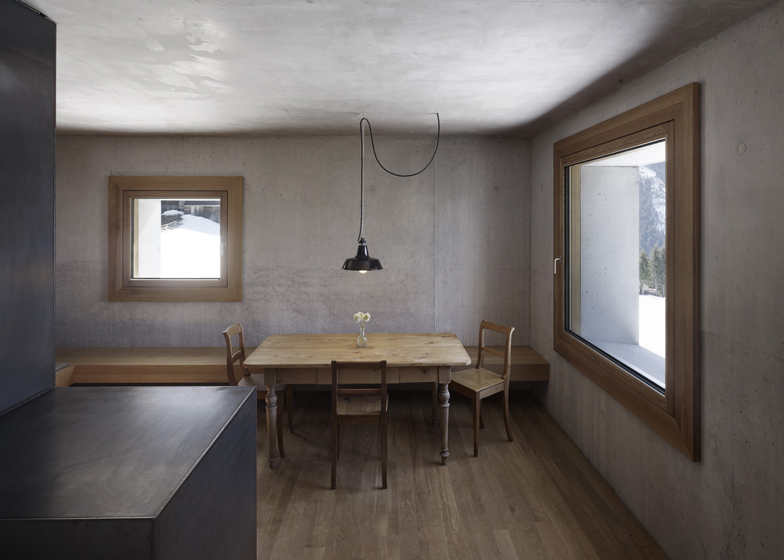Roughly hewn concrete gives a rocky texture to the walls of this Alpine holiday home by Austrian studio Marte.Marte Architects (+ slideshow).
The four-storey Mountain Cabin was constructed by Marte.Marte Architects on the side of a hillside in Laterns, Austria, and boasts far-stretching views of the surrounding mountains and forests.
Two rectangular openings wrap around the rectilinear body of the house, dividing it into two and creating a sheltered outdoor terrace on the upper-middle floor. This level functions as the building's entrance and can be accessed via a staircase at the rear.
A second staircase spirals down from this floor to bedrooms and storage areas on the lower levels and up to an open-plan kitchen and living room on the uppermost floor.
Smooth concrete walls and ceilings are left exposed inside the house and contrast with the rugged surface of the facade. Floors, doors and window frames are oak, as is much of the furniture.
Square windows are dotted around each elevation and are the only other interruption to the clean lines of the facade.
"The openings punched into the double-walled concrete shell are transformed into framed landscape paintings," says the studio, describing the views from the windows.
We've published a few houses in the mountains of Austria, including a boxy concrete house surrounded by sloping meadows and a cabin built from locally sourced spruce, fir and elm. See more houses in Austria.
Other winter retreats we've featured include a snowboarding cabin in Canada and a contemporary Alpine chalet. See more winter retreats on Dezeen.
Photography is by Marc Lins.
Here's a project description from Marte.Marte Architects:
Mountain cabin in Laternser valley
At the edge of a wooded ravine, beneath the imposing wooden house of the Catholic Community of Sisters, the small tower building rises from the steep hillside.
Striking and modest in appearance, it stretches up out of a small hollow situated on a narrow path along the edge of the forest.
The only change made to the hillside is the driveway and the terrain has been left in its original form.
Fitting into the landscape as if it were a barn, the building, which is a fine example of the homogeneous use of materials, in this case, carefully hewn rough concrete, stands out against the meadow green and winter white. Its ashy-gray colour only contrasts slightly with the heavy oak front doors and the anthracite-coloured handrails blend in with the branches of the surrounding forest. As if they were punched into the walls, the square windows of different sizes are spread out across the walls, and their full effect is only achieved at the corners.
The integration of the outer surfaces requested by the client is a kind of artifice. At the entry level, which is accessible via a flight a steps, the structure narrows down to two supporting corner columns, which not only provides guests with the unique opportunity to look through the building while at the same time enjoying a panorama view of the surrounding landscape, the whole time protected from the elements, but also lends the entrance a sense of significance.
Inside the column, a spiral staircase connects the living area on the upper level with the two more private areas on the lower level, where the bedrooms and relaxation areas are interlocked like a puzzle. Semantically speaking, this gesture of the tower creates archetypes of fortified structures and abstract computer figures in your mind's eye, making the tower seem familiar and strange at one and the same time.
Inside, the openings punched into the double-walled concrete shell are transformed into framed landscape paintings by wide, matte solid oak window frames that do not take up much wall space. These framed windows direct the guest's attention to the prominent mountain chain, the gentle slopes and the dense forest grove.
Besides the raw concrete surfaces and the untreated oak floors, doors and fixtures, the black metal surfaces complement the harmonious, austere combination of materials. The client and architects haven't built a flimsy holiday house, but instead a place of retreat that will remain standing for generations, despite any forthcoming changes of climate and landscape.
Client: private
Planning: Marte.Marte Architekten
Location: 6830 Laterns-Vorarlberg-Austria
Site area: 485.4 sqm
Gross floor area: 102.6 sqm
Floor area: 87 sqm
Built-up area: 43.03 sqm














